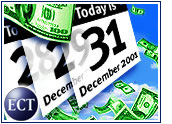
News flash: E-commerce grew fast … in the year 2000.
This pithy bit of earth-shattering news came courtesy of the U.S. government. To be more precise, it came from the U.S. Census Bureau , which is under the auspices of the Economics and Statistics Administration, which in turn is a division of the Department of Commerce.
Got all that? It’s only important because it might help explain why it took nearly 16 months for the Census Bureau to release this information.
And with all those layers of bureaucracy, there has to be someone in a cubicle in a government office building somewhere who actually thinks this information is helpful. Too bad no one outside the Beltway could possibly agree.
More Reports
Rumor has it that the bureau is also planning an in-depth look at Y2K and is putting finishing touches on a study of the economic impact of the 1984 summer Olympics in Los Angeles.
Seriously, someone should tell Census that this is the turn-on-a-dime digital economy we’re talking about. Information is only as useful as it is fresh, and stuff from 2000 is, well, a bit stale.
Credit Due
To be sure, the Census conducted what appears to be the most in-depth survey to date of how e-commerce was being used back in 2000, surveying 125,000 businesses in a range of sectors.
That survey found that business-to-business e-commerce was the bully of the block, making up 94 percent of all e-commerce transactions. It found manufacturing was leading the way, accounting for US$777 billion in e-commerce transactions that year. It found that in total, online transactions totaled $1 trillion, far more than previously believed.
The Census Bureau also discovered that electronic data interchanges, or EDIs, were an important foundation for e-commerce, and that business-to-consumer sales were lagging well behind but were growing quickly.
Thank You, Please
Insightful stuff. Something that many of us no doubt could have put to good use in, say, early 2001. Maybe even mid-2001. But at the end of the first quarter of 2002? This is ancient history. They might as well spend their time translating Sanskrit tablets.
What types of decisions are we supposed to make based on two-year-old data? The Census pointed out that trends are trends. They don’t reverse, especially when e-commerce is paying off in terms of savings for companies that adopted it early.
True enough. But knowing that a trend is continuing and getting your hands around the size of it are two different things.
Elusive Creature
The economy is a funny beast, and the e-commerce sector is no different. Few things get poked, prodded, analyzed, studied and evaluated as much as the economy. And rarely are prognosticators right. Even government data, awaited breathlessly by the stock markets when it is released at precisely the same moment each month, is often revised later.
All a real-data report is good for is to provide a snapshot in time anyway. In the time that elapses between the end of the data collection period for, say, unemployment and the release of the report, a flood of new claims could have been filed.
Those snapshots are valuable, though, because they are the most timely, most official information available. And, to be sure, no private organization can afford to undertake the kind of exhaustive study the government did on e-commerce way back when.
Remember When?
Also,the study does underscore, in heavy black lines, what everyone already suspected or at least hoped: that e-commerce was more widespread, more deeply ingrained, than even insiders fully understood.
That alone makes the Census report worth the paper it’s printed on.
Beyond that, its value is limited to nostalgia. Like a postcard from a bygone era, the government’s e-commerce data from 2000 says little more than, “Wish you were here.”
What do you think? Let’s talk about it.
Note: The opinions expressed by our columnists are their own and do not necessarily reflect the views of the E-Commerce Times or its management.

























































Social Media
See all Social Media